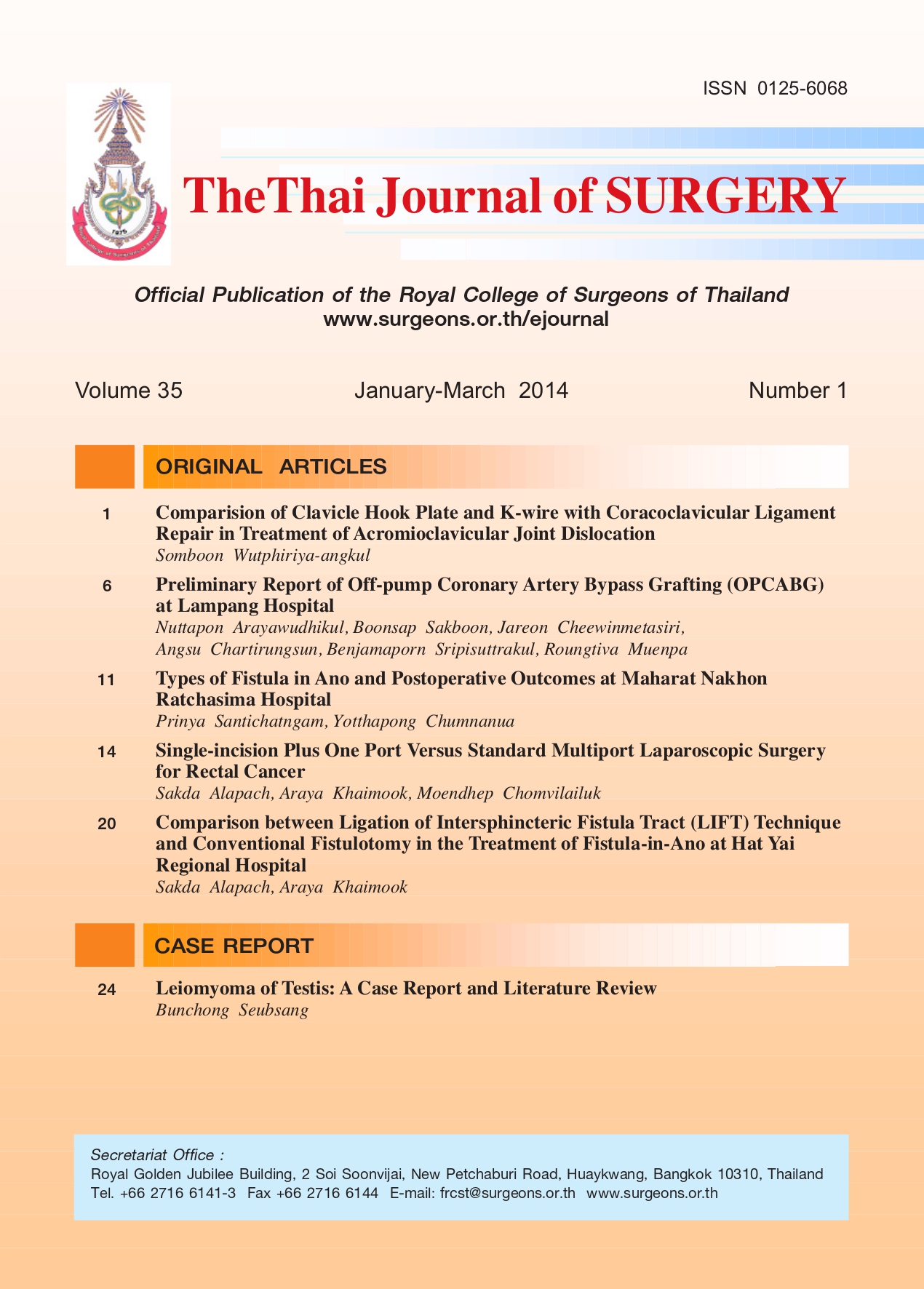Comparison between Ligation of Intersphincteric Fistula Tract (LIFT) Technique and Conventional Fistulotomy in the Treatment of Fistula-in-Ano at Hat Yai Regional Hospital
Keywords:
Fistula-in-ano, Ligation of intersphincteric fistula tract, FistulotomyAbstract
Background and objective: Treatment of fistula-in-ano remains challenging. The conventional fistulotomy has acceptable healing rate but may result in a large open wound and incontinence. The ligation of the intersphincteric fistula tract (LIFT), a new sphincter-saving technique, was devised in 2009 for the treatment of transsphincteric or horseshoe fistula-in-ano. The objective of the present study was to compare outcomes between the LIFT technique and conventional fistulotomy for the treatment of fistula-in-ano at Hatyai Hospital.
Materials and Methods: A retrospective analysis was performed on data collected at the Department of Surgery, Hatyai Hospital, from January 2009 to September 2013.
Results: There were 85 patients of whom 48 underwent the LIFT technique, and 37 underwent conventional fistulotomy. The average operative time for fistulotomy was significantly shorter at 21.4 minutes, compared with 35.1 minutes for LIFT (p < 0.001). The median follow up time was 41 weeks in the LIFT group, and 52 weeks in the fistulotomy group. The average healing time for LIFT was 2 weeks vs. 6 weeks for fistulotomy (p < 0.01), and the proportion of postoperative anal incontinence was 2.1% vs. 16.2% (p < 0.01) for the LIFT vs. fistulotomy, respectively. The healing rates were similar for both groups (79% and 78%, p = 0.93, for LIFT and fistulotomy groups, respectively).
Conclusion: Fistula-in-ano can be treated successfully by the LIFT technique, with shorter healing time, and lower incidence of postoperative anal incontinence.
References
2. Ramanujam PS, Prasad ML, Abcarian H, Tan AB. Perianal abscesses and fistulas. A study of 1023 patients. Dis ColonRectum 1984;27:593-7.
3. Vasilevsky CA, Gordon PH. The incidence of recurrentabscesses or fistula-in-ano following anorectal suppuration. Dis Colon Rectum 1984;27:126-30.
4. Whiteford MH, Kilkenny III J, Hyman N, et al. AmericanSociety of Colon and Rectal Surgeons. Practice parameters for the treatment of perianal abscess and fistula-in-ano (revised). Dis Colon Rectum 2005;48:1337-42.
5. Parks AG. Pathogenesis and treatment of fistula-in-ano. Br Med J 1961;1:463-9.
6. Eisenhammer S. The internal anal sphincter and the anorectal abscess. Surg Gynecol Obstet 1956;103:501-6.
7. Sainio P. Fistula-in-ano in a defined population. Incidence and epidemiological aspects. Ann Chir Gynaecol 1984;73:219-24.
8. Abcarian H. Anorectal infection: abscess-fistula. Clin ColonRectal Surg 2011;24:14-21.
9. Rojanasakul A, Pattanaarun J, Sahakitrungruang C, Tantiphlachiva K. Total anal sphincter saving technique for fistula-in-ano; the ligation of intersphincteric fistula tract. J Med Assoc Thai 2007;90:581-6.
10. Rojanasakul A. LIFT procedure: a simplified technique for fistula-in-ano. Tech Coloproctol. 2009;13:237-40.
11. Murugesan J, Morb I, Fullhamc S, Hitosda K. Systematic review of efficacy of LIFT procedure in crpytoglandular fistula-in-ano. J Coloproctol 2014. http://dx.doi.org/10.1016/j.jcol.2014.02.008
12. Jorge JMN, Wexner SD. Etiology and management of fecal incontinence. Dis Colon Rectum 1993;36:77-97.
13. Vaizey CJ, Carapeti E, Cahill JA, Kamm MA. Prospective comparison of faecal incontinence grading systems. Gut 1999;44:77-80.
14. Mushaya C, Bartlett L, Schulze B, Ho Y-H. Ligation of intersphincteric fistula tract compared with advancement flap for complex anorectal fistulas requiring initial seton drainage. Am J Surg 2012;204:283-9.
15. Shanwani A, Nor AM, Amri N. Ligation of the intersphincteric fistula tract (LIFT): a sphincter-saving technique for fistula-inano. Dis Colon Rectum 2010;53:39-42.
16. Alasari S, Kim NK. Overview of anal fistula and systematic review of ligation of the intersphincteric fistula tract (LIFT). Tech Coloproctol 2014;18:13-22.
17. Cui J, Wang Z, Zheng Y, Han J, Yang X. [Ligation of the intersphincteric fistula tract plus bioprosthetic anal fistula plug (LIFT-plug) in the treatment of transsphincteric perianal fistula]. Zhonghua Wei Chang Wai Ke Za Zhi 2012;15:1232-5.
18. Aboulian A, Kaji AH, Kumar RR. Early result of ligation of the intersphincteric fistula tract for fistula-in-ano. Dis Colon Rectum 2011;54:289-92.
19. Alasari S, Kim NK. Overview of anal fistula and systematic review of ligation of the intersphincteric fistula tract (LIFT). Tech Coloproctol 2014;18:13-22.
20. Rizzo JA, Naig AL, Johnson EK. Anorectal abscess and fistulain- ano: evidence-based management. Surg Clin North Am 2010;90:45-68.
Downloads
Published
How to Cite
Issue
Section
License
Articles must be contributed solely to The Thai Journal of Surgery and when published become the property of the Royal College of Surgeons of Thailand. The Royal College of Surgeons of Thailand reserves copyright on all published materials and such materials may not be reproduced in any form without the written permission.



